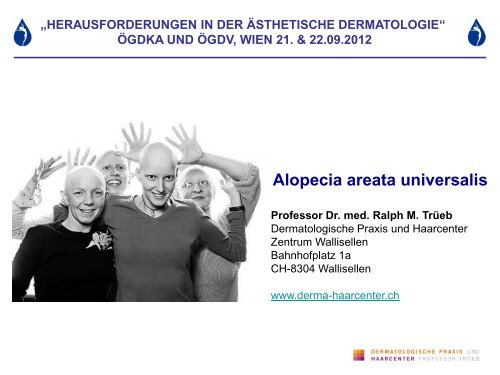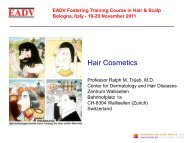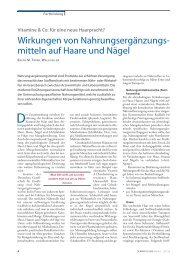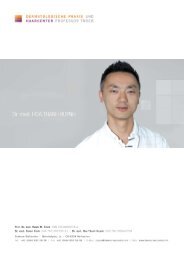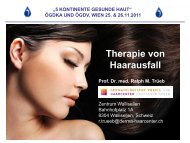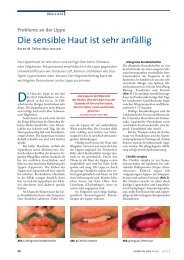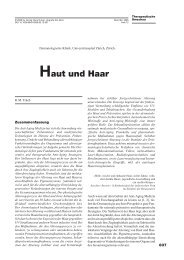Alopecia universalis - Dermatologische Praxis und Haarcenter ...
Alopecia universalis - Dermatologische Praxis und Haarcenter ...
Alopecia universalis - Dermatologische Praxis und Haarcenter ...
Sie wollen auch ein ePaper? Erhöhen Sie die Reichweite Ihrer Titel.
YUMPU macht aus Druck-PDFs automatisch weboptimierte ePaper, die Google liebt.
„HERAUSFORDERUNGEN IN DER ÄSTHETISCHE DERMATOLOGIE“,<br />
ÖGDKA UND ÖGDV, WIEN 21. & 22.09.2012<br />
<strong>Alopecia</strong> areata <strong>universalis</strong><br />
Professor Dr. med. Ralph M. Trüeb<br />
<strong>Dermatologische</strong> <strong>Praxis</strong> <strong>und</strong> <strong>Haarcenter</strong><br />
Zentrum Wallisellen<br />
Bahnhofplatz 1a<br />
CH-8304 Wallisellen<br />
www.derma-haarcenter.ch
<strong>Alopecia</strong> areata<br />
Definition:<br />
Wahrscheinlich organspezifische<br />
Autoimmunkrankheit des Haarfollikels<br />
Mit gewöhnlich rasch, umschrieben,<br />
<strong>und</strong> in unterschiedlicher Ausdehnung auftretendem,<br />
nicht vernarbenden Haarausfall<br />
<strong>und</strong> im Einzelfall unberechenbarem,<br />
schubweise rezidivierenden Verlauf<br />
Klinische Präsentationsformen <strong>und</strong><br />
Differentialdiagnosen<br />
Trüeb RM. Haare. <strong>Praxis</strong> der Trichologie. Steinkopff Darmstadt 2003<br />
Ätiopathogenese <strong>und</strong> Krankheitsassoziationen<br />
(Korrelation zu) Prognose mit/ohne Therapie
Klinische Präsentationsformen<br />
AA vulgaris AA diffusa AA totalis/<strong>universalis</strong><br />
Aus: Trüeb RM. Haare. <strong>Praxis</strong> der Trichologie. Steinkopff Darmstadt 2003<br />
Ophiasis AA reticularis
Differentialdiagnosen: Atrichia congenita <strong>universalis</strong><br />
Sehr seltene hereditäre Atrichie (Gendefekt auf 8p12), bei der die Haare kurz nach<br />
Geburt <strong>und</strong> spätestens innerhalb des 1. Lebensjahres ausfallen<br />
Histologisch Fehlen von Haarfollikeln <strong>und</strong> mit Hornmassen gefüllte, kleine<br />
dyskeratotische Follikelzysten (Atrichie mit Hornzysten)<br />
Klinisch zahlreiche kleine follikulär geb<strong>und</strong>enr, mit Hornmassen gefüllten Zysten mit<br />
Prädilektion für den Nacken <strong>und</strong> das Gesicht, hier auch als Atrophodermia<br />
vermiculata<br />
Ahmad et al. <strong>Alopecia</strong> <strong>universalis</strong> associated with a mutation in the human hair<br />
less gene. Science 1998;279:720-24
Differentialdiagnose: Generalisierte Mucinosis follicularis<br />
Alopezische Plaques (<strong>Alopecia</strong> mucinosa) mit follikulären Papeln <strong>und</strong> dem hoch<br />
charakteristischen Bef<strong>und</strong> degenerativer Veränderung des Follikelepithels mit<br />
Ansammlung von Mucin im Haarfollikel, selten generalisiert<br />
Assoziation mit kutanem T-Zelllymphom (gewöhnlich Mycosis fungoides)<br />
vorallem in älteren Patienten (4.-7. Dezennium)<br />
Trüeb RM, Bruckner-Tuderman L. Genralisierte Mucinosis follicularis idiopathica.<br />
Hautarzt 1990;41:625-627
Differentialdiagnose: Alopezie bei Sézary Syndrom<br />
Leukämische Verlausform eines kutanen T-Zell-Lymphoms mit Erythrodermie,<br />
generalisierter Lymphknotenschwellung <strong>und</strong> Zirkulation atypischer Zellen mit<br />
zerebriformen Kernen (Sèzary-Lutzner Zellen)<br />
Neben einem entzündlichen Ödem mit Facies leontina-artiger Infiltration der<br />
Gesichtshaut diffuse Alopezie infolge Mitbeteiligung des Kapillitiums<br />
Bi et al. The spectrum of hair loss in patients with mycosis fungoides and Sézary syndrome.<br />
J Am Acad Dermatol. 2011;64:53-63
Ätiopathogenese: Organspezifische Autoimmunkrankheit<br />
Histopathologie:<br />
- Peribulbäres lymphohistiozytäres<br />
Entzündungsinfiltrat<br />
King et al. <strong>Alopecia</strong> areata. Curr Dir Autoimmun. 2008;10:280-312.<br />
Immungenetische Assoziationen:<br />
- HLA-Haplotypen<br />
- Zytokin-Genpolymorphismen<br />
- susceptibility genes<br />
- severity genes<br />
Assoziation mit zirkulierenden Antikörper:<br />
- Schilddrüse<br />
- Magenparietalzellen<br />
- Haar-spezifische Antigene<br />
Assoziation mit anderen Autoimmunkrankheiten<br />
Ansprechen auf immunmodulierende Therapien:<br />
- Kortikosteroide<br />
- Cyclosoporin<br />
- Topische Immunotherapie mit DCP oder SADBE<br />
- Biologics?
Krankheitsassoziationen/Komorbiditäten<br />
Andere Autoimmunkrankheiten:<br />
- Autoimmunthyreoiditis (7-27%)<br />
- Chronische atrophische Gastritis/Perniciosa (Vit. B12 Mangel)<br />
- Vitiligo<br />
- Vogt-Koyanaga-Harada Syndrom<br />
- Autoimmun-Polyendokrinopathie<br />
- Lupus erythematodes<br />
Eisenmangel: Serumferritinspiegel bei<br />
- AGA 37.3 ng/ml<br />
- <strong>Alopecia</strong> areata vulgaris 24.9 ng/ml<br />
- <strong>Alopecia</strong> areata totalis 52.3 ng/ml<br />
- Telogeneffluvium 50.1 ng/ml<br />
- Ges<strong>und</strong>e Kontrollen 59.5 ng/ml<br />
Kantor et al. Decreased serum ferritin is associated with alopecia in women. J Invest Dermatol 2003;121:985-8<br />
Psychopathologien:<br />
- Trichotillomanie<br />
Trüeb <strong>und</strong> Cavegn. Trichotillomania in connection with alopecia areata. Cutis 1996;58:67-70<br />
- andere<br />
Komorbiditätenscreening
Autoimmunpolyendokrinopathie-Syndrom<br />
Derzeit einzige bekannte monogen vererbte<br />
Autoimmunerkrankung (AR, Mutation des AIRE-<br />
oder Autoimmun-Regulator- Gen):<br />
Leitsymptome sind:<br />
• M. Addison<br />
• Hypoparathyreoidismus<br />
• chronische mukokutane Candidiasis<br />
Fakultativ entwickeln sich weitere, autoimmunbedingte<br />
Erkrankungen wie:<br />
• Diabetes mellitus Typ 1<br />
• Thyreoiditis<br />
• perniziöser Anämie bei chronisch atrophischer<br />
Gastritis<br />
• hypergonadotroper Hypogonadismus.<br />
• Alopezie<br />
• Vitiligo<br />
Böni R, Trüeb RM, Wüthrich B. <strong>Alopecia</strong> areata in a patient with candidiasis-endocrinopathy syndrome:<br />
unsuccessful treatment trial with diphenylcyclopropenone. Dermatology 1995;191:68-71
Lupus Erythematodes<br />
Morphologisch, charakteristische, oft im Gesicht <strong>und</strong> am Kapillitium lokalisierte, mit<br />
Rötung, Schuppung <strong>und</strong> Atrophie einhergehende, autoimmun bedingte entzündliche<br />
Dermatose mit Chronizitätsneigung<br />
Klinisch unterschiedliche Präsentationsformen:<br />
• chronisch diskoider Lupus erythematodes<br />
• diffuses Telogeneffluvium/Lupushaare bei systemischem Lupus erythematodes<br />
• <strong>Alopecia</strong> areata-artige Alopezie bei systemischem Lupus erythematodes<br />
Trüeb RM. Involvement of scalp and nails in lupus erythematosus. Lupus. 2010;19:1078-86
Infliximab-induzierte <strong>Alopecia</strong> <strong>universalis</strong><br />
Fälle von Auftreten oder Verschlechterung einer <strong>Alopecia</strong> areata bis zur Ausbildung<br />
einer <strong>Alopecia</strong> <strong>universalis</strong> unter TNF-alpha Blockade<br />
Pelivani et al. <strong>Alopecia</strong> areata <strong>universalis</strong> elicited during treatment with adalimumab. Dermatology 2008;216:320-3
<strong>Alopecia</strong> Universalis <strong>und</strong> HIV-Infektion<br />
Es wurde über Auftreten einer <strong>Alopecia</strong> areata <strong>universalis</strong> sowohl unter HIV-<br />
Infektion als auch unter HAART Therapie bei Patienten mit AIDS berichtet.<br />
Stewart MI, Smoller BR. <strong>Alopecia</strong> <strong>universalis</strong> in an HIV-positive patient: possible insight into pathogenesis.<br />
J Cutan Pathol. 1993;20:180-3<br />
Sereti et al. <strong>Alopecia</strong> <strong>universalis</strong> and Graves' disease in the setting of immune restoration after highly active<br />
antiretroviral therapy. AIDS. 2001;15:138-40
Therapie: Was hat uns die EBM zu sagen?<br />
„17 trials ... with a total of 540 participants. Each trial included 6-85 participants<br />
and assessed a range of interventions that included: topical and oral<br />
corticosteroids, topical ciclosporin, photodynamic therapy, topical minoxidil.<br />
None showed significant treatment benefit in terms of hair growth when<br />
compared with placebo.“<br />
„Few treatments have been well evaluated in randomised trials. We fo<strong>und</strong> no<br />
RCTs on the use of DCP, DNCB, intralesional corticosteroids or dithranol,<br />
although commonly used. Although topical steroids and minoxidil are widely<br />
prescribed and appear to be safe, there is no convincing evidence that they are<br />
beneficial in the long-term. Most trials have been reported poorly and are so<br />
small that any important clinical benefits are inconclusive.“<br />
„Considering the possibility of spontaneous remission especially for those in the<br />
early stages of the disease, the options of not being treated therapeutically<br />
or, depending on individual preference wearing a wig may be alternative<br />
ways of dealing with this condition.“<br />
Delamere et al. Interventions for alopecia areata. Cochrane Database Syst Rev. 2008 16;(2):CD004413
Prognose<br />
Spontanremissionsraten initialer Attacken:<br />
• 1/3 innerhalb 6 Monate<br />
• 1/2 innerhalb eine Jahres<br />
• 2/3 innerhalb 5 Jahre, danach kommen<br />
vollständige Heilungen nur noch selten vor.<br />
Rezidivrate:<br />
• Innerhalb 5 Jahren 80%<br />
• Bei >20-jähriger Nachbeobachtungszeit praktisch<br />
100%.<br />
Prognose der <strong>Alopecia</strong> totalis/<strong>universalis</strong><br />
(5 Jahre <strong>und</strong> mehr):<br />
• Vollständige Abheilung bei 1% betroffener Kinder<br />
• <strong>und</strong> bei 10% der Erwachsenen.
Prognosefaktoren<br />
Ikeda I: Ohne Assoziation (> 80%)<br />
Beginn zwischen 20 <strong>und</strong> 40<br />
Bestehen des Einzelherds < 6 Monate<br />
Krankheitsdauer < 3 Jahre<br />
Übergang in <strong>Alopecia</strong> totalis in < 10%<br />
Ikeda II: Assoziation mit Atopie (10%)<br />
Beginn of vor dem 20. Lebensjahr<br />
multilokulär, retikulär, Ophiasis<br />
Bestehen des Einzelherdes > 1 Jahr<br />
Übergang in <strong>Alopecia</strong> totalis in 75%<br />
Ikeda III: Junge Erwachsene aus Hypertonikerfamilien (< 5%)<br />
Retikulärer Typ<br />
Übergang in <strong>Alopecia</strong> totalis in knapp 40%<br />
Ikeda IV: Assoziation mit Autoimmunendokrinopathie (< 5%)<br />
Beginn häufig nach 40. Lebensjahr<br />
Chronizitätsneigung<br />
Übergang in <strong>Alopecia</strong> totalis in 10%<br />
Ikeda. A new classification of alopecia areata. Dermatologica 1965;131:421-45
Prognosefaktoren<br />
Inzidenz des Unna-Politzer Nackennaevus:<br />
- <strong>Alopecia</strong> totalis/<strong>universalis</strong> 22.8 %<br />
- <strong>Alopecia</strong> areata vulgaris 3.6 %<br />
- Ges<strong>und</strong>e Kontrollen 4.5 %<br />
Hatzis et al. Nuchal nevus flammeus as a skin marker of prognosis in<br />
alopecia areata. Dermatologica 1988;177:149-51<br />
Bei Nagelbeteiligung schlechteres Ansprechen auf die<br />
topische Immunotherapie mit DCP oder SADBE<br />
van der Steen et al. Prognostic factors in the treatment of alopecia areata<br />
with diphenylcyclopropenone. J Am Acad Dermatol 1991;24:227-30<br />
Ajith et al. Efficacy and safety of the topical sensitizer squaric acid dibutyl<br />
ester in <strong>Alopecia</strong> areata and factors influencing the outcome. J Drugs<br />
Dermatol. 2006;5:262-6
Nagelbeteiligung<br />
Rote Lunulae Trachyonychie (>10%)<br />
Aus: Trüeb RM. Haare. <strong>Praxis</strong> der Trichologie. Steinkopff Darmstadt 2003<br />
Tüpfelnägel (> 30%)
Negative Prognosefaktoren (Zusammenfassung)<br />
Jugendliches Erstmanifestationsalter<br />
(vor Pubertät)<br />
Lange Krankheitsdauer<br />
Ophiasis<br />
Grosse Ausdehnung (<strong>Alopecia</strong> totalis,<br />
<strong>Alopecia</strong> <strong>universalis</strong>)<br />
Nagelbeteiligung<br />
Assoziation mit atopischem Ekzem<br />
Assoziation mit<br />
Autoimmunpolyendokrinopathie
Therapie: Was hat uns GMP zu sagen?<br />
„Es gibt keine verlässliche <strong>und</strong> nebenwirkungsfreie Therapieform, mit der<br />
Wiederwachstum von Haaren <strong>und</strong> eine dauerhafte Stabilisierung des eventuell<br />
wieder erreichten Haarbestands gewährleistet ist.“<br />
Trüeb RM. Haare. <strong>Praxis</strong> der Trichologie. Steinkopff Darmstadt 2003<br />
Bei Fehlen überzeugender Daten guter, randomisierter,<br />
doppelblind Placebo-kontrollierter Studien, misst sich der<br />
Erfolg einer Therapie der <strong>Alopecia</strong> areata:<br />
• an der Wirksamkeit im Halbseitenversuch bei <strong>Alopecia</strong> totalis<br />
• an einer gegenüber dem Spontanverlauf höheren<br />
Remissionsrate<br />
• an einem hohen Sicherheitsprofil mit minimaler Toxizität<br />
• an der Verbesserung der Lebensqualität
Halbseitenversuch: Topische Kortikosteroide<br />
28 Patienten mit <strong>Alopecia</strong> totalis/<strong>universalis</strong> > 1 Jahr<br />
Tgl. Anwendung von Clobetasolpropionat 0.5% Salbe okklusiv 6 x wöchentlich über 6<br />
Monate, 6 Monate Nachbeobachtungszeit<br />
Tosti et al. Clobetasol propionate 0.05% <strong>und</strong>er occlusion in the treatment of alopecia<br />
totalis/<strong>universalis</strong>.J Am Acad Dermatol. 2003;49:96-8.<br />
8/28 (28.5%) Nachwachsen von Haaren<br />
Haarwachstum innerhalb 6-14 Wochen<br />
Bei 3/8 Rückfall innerhalb Beobachtungszeit<br />
von insgesamt 12 Monaten<br />
Erfolg insgesamt: 17.8% (5/28)<br />
Negative prognostische Faktoren:<br />
• Positive Familienanamnese<br />
• Beginn vor 10. Lebensjahr<br />
• Atopie<br />
• Autoimmunthyreoiditis<br />
UEW: Follikulitis/Akne in 12/28
Halbseitenversuch: Topische Immunotherapie (DCP)<br />
Remission: Keine Partial Total<br />
AA multilocularis 12.5% 43,8% 43,8%<br />
AA subtotalis, Ophiasis 20,8% 45,8% 33,3%<br />
AA totalis/<strong>universalis</strong> 46,4% 32,1% 21,4%<br />
________________________________________________<br />
Total: 30,9%<br />
Pericin <strong>und</strong> Trüeb. Topical immunotherapy of severe alopecia areata with diphenylcyclopropenone: evaluation of 68<br />
cases. Dermatology 1998;196:418-21
Systemische Kortikosteroide<br />
Methylprednisolon-Pulstherapie:<br />
500 mg i.v. an 3 Tagen, 3x im Abstand von 4 Wochen (optional)<br />
<strong>Alopecia</strong> areata Dauer < 6 Monate:<br />
< 50% Fläche: 88.0% Erfolg<br />
> 50% Fläche: 59.4% Erfolg<br />
<strong>Alopecia</strong> totalis: 21.4% Erfolg<br />
Dauer > 6 Monate: 15.8% Erfolg<br />
Nakjima et al. Pulse corticosteroid therapy for<br />
alopecia areata: study of 139 patients.<br />
Dermatology 2007;215:320-324<br />
Orale Minipulstherapie:<br />
5 mg Betamethason an 2 aufeinanderfolgenden Tagen über 12 - 24 Wochen<br />
Agarwal et al. Twice weekly 5 mg betamethasone oral pulse therapy in the treatment of<br />
alopecia areata. J Eur Acad Dermatol Venereol. 2006;20:1375-6.<br />
Im Quervergleich i.v. Methylprednisolon Pulstherapie am wirksamsten<br />
Kurosawa et al. A comparison of the efficacy, relapse rate and side effects among three<br />
modalities of systemic corticosteroid therapy for alopecia areata.<br />
Dermatology. 2006;214:361-5
Methotrexate<br />
22 Patienten mit AA totalis/<strong>universalis</strong> > 1 Jahr<br />
MTX 15 - max. 30 mg/Wo bis max. 18 Monate nach Wiederwachstum von Haaren<br />
+ Prednison 20 mg bis Haarwachstum, dann über 6-12 Monaten ausgeschlichen<br />
Vollremission bei 64% (16/22):<br />
68% (11/16) mit kombinierter Therapie<br />
50% (3/6) mit Mtx (> 20 mg) allein<br />
Nachwachsen von Haaren innerhalb 3-6<br />
Monaten:<br />
Kombinierte Therapie 2-4 Monate<br />
Mtx allein 5-7 Monate<br />
Joly P. The use of methotrexate alone or in combination with low doses of oral corticosteroids in the treatment<br />
of alopecia totalis or <strong>universalis</strong>.J Am Acad Dermatol. 2006;55:632-6
Phototherapie<br />
The results of PUVA treatment for severe alopecia areata (AA) were<br />
reviewed in 102 patients. 53% had greater than 90% regrowth of hair.<br />
Although these results appear to be encouraging, they differ little from<br />
what would be expected with no treatment. We consider that PUVA is<br />
not an effective treatment for AA.<br />
Healy, Rogers S. PUVA treatment for alopecia areata--does it work? A<br />
retrospective review of 102 cases<br />
Br J Dermatol. 1993;129:42-4<br />
Effective success rate was at best 6.3% for alopecia areata partialis,<br />
12.5% for alopecia areata totalis and 13.3% for alopecia areata<br />
<strong>universalis</strong>. We affirm that PUVA is generally not an effective<br />
treatment for alopecia areata.<br />
Taylor <strong>und</strong> Hawk. PUVA treatment of alopecia areata partialis, totalis<br />
and <strong>universalis</strong>: audit of 10 years' experience at St John's Institute of<br />
Dermatology.Br J Dermatol. 1995;133:914-8<br />
Minimal benefit from photochemotherapy for alopecia areata.<br />
Alabdulkareem et al. Int J Dermatol. 1996;35:890-1.
Phototherapie: Variationen<br />
Turban-PUVA:<br />
811nm-Excimer Laser:<br />
Behrens-Williams et al. The PUVA-turban as a new option of applying a dilute psoralen<br />
solution selectively to the scalp of patients with alopecia areata. J Am Acad Dermatol.<br />
2001;44:248-52.<br />
Broniarczyk-Dyla et al. Effects of psoralen-UV-A-Turban in alopecia areata. Skinmed.<br />
2006;5:64-8.<br />
G<strong>und</strong>ogan et al. Treatment of alopecia areata with the 308-nm xenon chloride excimer<br />
laser: case report of two successful treatments with the excimer laser. Lasers Surg Med.<br />
2004;34:86-90.<br />
Zakaria et al. 308-nm excimer laser therapy in alopecia areata. J Am Acad Dermatol.<br />
2004;5:837-8. 6:<br />
Raulin et al. Excimer laser therapy of alopecia areata--side-by-side evaluation of a<br />
representative areata. J Dtsch Dermatol Ges. 2005;3:524-6.<br />
Al-Mutairi. 308-nm excimer laser for the treatment of alopecia areata. Dermatol Surg.<br />
2007;33:1483-7.
Andere systemische Therapien<br />
Cyclosporin (5 mg/kg KG tgl.)<br />
Cerottini et al. Multifocal alopecia areata during systemic cyclosporine A therapy.<br />
Dermatology. 1999;198:415-7.<br />
Sulfone (Dapsone, Sulfasalazin)<br />
van Baar et al. Dapsone versus topical immunotherapy in alopecia areata.<br />
Br J Dermatol. 1995 Aug;133(2):270-4<br />
Inosiplex (50 mg/kg in 5 Dosen tgl. während 12 Wochen)<br />
Inosiplex: 5/15 (33.3%) Vollremission, 8/15 (53.3%) Teilremission, 2/15 (13.3%) kein<br />
Erfolg<br />
Placebo: 0 Vollremission, 4 (28.5%) Teilremission, 10 (71.4%) keine Erfolg.<br />
Georgala et al. Inosiplex for treatment of alopecia areata: a randomized placebo-controlled<br />
study. Acta Derm Venereol. 2006;86:422-4.<br />
Erfolg in 9/14 Patienten, 7/9 erfolgreich behandelten Patienten wiesen zirkulierende<br />
Antikörper auf, die zum Teil unter Therapie negativieren<br />
Lowy et al. Clinical and immunologic response to Isoprinosine in alopecia areata and<br />
alopecia <strong>universalis</strong>: association with autoantibodies.<br />
J Am Acad Dermatol. 1985 Jan;12(1 Pt 1):78-84
Biologics (T-Zell gerichtet, TNF-Blocker)<br />
Heffernan et al. Alefacept for alopecia areata.<br />
Arch Dermatol 2005;141:1513-6<br />
Kaelin U et al. Treatment of alopecia areata partim <strong>universalis</strong><br />
with efalizumab. J Am Acad Dermatol 2006 :529-32.<br />
Price et al. Subcutaneous efalizumab is not effective in the treatment of alopecia areata.<br />
J Am Acad Dermatol 2008 ;58:395-402
Psychotherapie<br />
Psychotic State<br />
Neurotic<br />
Conflict Situation<br />
Emotional<br />
Factors<br />
Reactive<br />
Disorder<br />
Neurohumoral<br />
Link<br />
productive<br />
symptomatology<br />
direct<br />
expressive character<br />
Organ<br />
Dysfunction<br />
Tactile<br />
Hallucinosis<br />
Conversional<br />
Disorder<br />
Psychosomatic<br />
Organ Lesion?<br />
Psychosomatic Theory:<br />
Specific correlations between emotional drive and target organ;<br />
Constitutional vulnerability of target organ<br />
exacerbation<br />
psychosocial impact<br />
Somatic<br />
Disease<br />
Aus: Willemsen et al. Hypnotherapeutic<br />
management of alopecia areata.<br />
J Am Acad Dermatol. 2006;55:233-7<br />
Aus: Trüeb <strong>und</strong> Gieler. Psychocutaneous disorders of hair and scalp. In: Blume-<br />
Peytavi, Tosti, Whiting, Trüeb. Hair Growth and Disorders. Springer Berlin 2008<br />
Anpassungsstörungen:<br />
• Anpassungsstörung mit depressiver Verstimmung (F43.20)<br />
• Anpassungsstörung mit ängstlicher Gestimmtheit (F43.28)<br />
• Anpassungsstörung mit sozialer Verhaltensbeeinträchtigung (F43.24)
Psychopharmaka<br />
13 Patienten<br />
75 mg Imipramin (n=7) vs. Placebo (n=6) über 6 Monate<br />
Vollremission in:<br />
• 1/7 in Imipramin-Gruppe<br />
• 0/6 in Placebo-Gruppe<br />
Perini et al. Imipramine in alopecia areata. A double-blind,<br />
placebo-controlled study Psychother Psychosom. 1994;61:195-8<br />
13 Patienten (3 AT, 1 AU)<br />
20 mg Paroxetin (n=8) vs. Placebo (n=5) über 3 Monate<br />
Paroxetin:<br />
• 2/8 Vollremission<br />
• 4/8 Teilremission<br />
Placebo:<br />
• 1/5 Nahezu Vollremission<br />
Cipriani et al. Paroxetine in alopecia areata. Int J Dermatol 2001;40:600-1.
Aromatherapie<br />
86 Patienten mit AA (nicht näher bezeichnet), Therapie über 7 Monate, 7 Monate<br />
Nachbeobachtungszeit<br />
35/43 (81%) mit Aromatherapie (Thymus vulgaris 88 mg, Lavendula agustifilia 108<br />
mg, Rosmarinus officinalis 114 mg, Cedrus atlantica 94 mg) <strong>und</strong> 28/41 (68%) in der<br />
Kontrollgruppe (Vehikel: 3 ml Jojoba-Öl, 20 ml Traubenkernöl) schlossen die Studie ab<br />
Andere komplemetär-medizinische Therapien:<br />
• Akupunktur<br />
• Zwiebelsaft<br />
• Massage<br />
Signifikantes Haarwachstum („very good“ oder<br />
„excellent“) in<br />
54% (ITT:44%) mit Aromatherapie<br />
vs.<br />
21% (ITT:15%) in der Kontrollgruppe<br />
Hay et al. Randomized trial of aromatherapy. Successful<br />
treatment for alopecia areata. Arch Dermatol. 1998;134:1349-52.<br />
Ge S. Treatment of alopecia areata with acupuncture. J Tradit Chin Med. 1990<br />
Sep;10(3):199-200.<br />
Sharquie <strong>und</strong> Al-Obaidi. Onion juice (Allium cepa L.), a new topical treatment<br />
for alopecia areata. J Dermatol. 2002;29:343-6.<br />
Putt et al. A case study: massage, relaxation, and reward for treatment of<br />
alopecia areata. Psychol Rep 1994;74:1315-8.
<strong>Alopecia</strong> areata diffusa: Methylprednisolon-Pulstherapie<br />
F, 66 J., Methylprednisolonpulstherapie<br />
(3 x 500 mg i.v. an 3 aufeinanderfolgenden Tagen im Abstand von 1 Monat)
<strong>Alopecia</strong> areata totalis: Kortikosteroidokklusivtherapie<br />
M, 38-jährig, 6 Monate Clobetasolpropionat okklusiv
<strong>Alopecia</strong> areata subtotalis: DCP-Therapie<br />
F, 12-jährig, 12 Monate DCP Therapie (1.0%)
<strong>Alopecia</strong> areata totalis: MTX <strong>und</strong> Prednison<br />
F, 43 J., 18 Monate MTX 30 mg <strong>und</strong> Prednison 20 mg (mit späterer Dosisreduktion)
<strong>Alopecia</strong> areata totalis: Visualisierungsübungen<br />
F, 47-jährig, Visualisierungsübungen, 12 Monate
<strong>Alopecia</strong> areata subtotalis: TCM<br />
F, 11-jährig, Ce bai ye ding (TCM, Dr. med. H. T. Huynh), 3 Monate
Haarersatz<br />
„... the options of not being treated therapeutically<br />
or, depending on individual preference wearing a<br />
wig may be alternative ways of dealing with this<br />
condition.“<br />
Delamere et al. Interventions for alopecia areata.<br />
Cochrane Database Syst Rev. 2008 16;(2):CD004413<br />
CH: Kostenbeteiligung der AHV/IV (CHF 1‘200-<br />
1‘500.- pro Jahr)<br />
Voraussetzung: Perücke während mind. 1 Jahr<br />
benötigt<br />
Auf ärztliche Verordnung
Haarersatzoptionen: Turban<br />
Prinzessin Caroline von Monaco
Dermatographie (Permanent Make Up)<br />
Aus: van der Velden et al. Dermatography as a new treatment for alopecia areata of the eyebrows.<br />
Int J Dermatol 1998;37:617-621
Selbsthilfegruppen <strong>und</strong> Foren<br />
www.kreisr<strong>und</strong>erhaarausfall.de<br />
<strong>Alopecia</strong> Areata Deutschland (AAD) e.V.<br />
www.haarlos-in-hamburg.de<br />
<strong>Alopecia</strong> Areata Gruppe, Hamburg<br />
www.alopeciaareata.at<br />
<strong>Alopecia</strong> Areata Gruppe, Österreich<br />
www.christine-thon.de/Projekte/<strong>Alopecia</strong>_areata<br />
Betroffenenseite<br />
www.alopeciaareata.com<br />
Englischsprachige Homepage der Selbsthilfeorganisation<br />
"National <strong>Alopecia</strong> Areata Fo<strong>und</strong>ation“ (NAAF), USA<br />
www.alopezie.de<br />
Infos <strong>und</strong> Foren zum Thema Haarausfall<br />
www.onmeda.de/foren/forum-haarausfall<br />
Forum zum Thema Haarausfall<br />
www.haircoaching.de/information<br />
Jenny Latz HairCoaching
Keine Therapie oder<br />
Placebotherapie:<br />
• Hydrokortison 1%<br />
• Mometason<br />
• Anthralin<br />
• Zinkglukonat<br />
Kein Erfolg<br />
Prof. R.M. Trüeb, 2012<br />
ALOPECIA AREATA<br />
ALTER<br />
< 10 Jahre > 10 Jahre<br />
Intraläsionale Kortikosteroide:<br />
• Kinder: 5 mg/ml<br />
• Erwachsene: 10 mg/ml<br />
• Augenbrauen: 2.5 mg/ml<br />
+ Minoxidil<br />
+ Zinkglukonat<br />
< 30%<br />
% Flächenbefall<br />
> 30%<br />
Krankheitsdauer<br />
< 6 Monate > 6 Monate<br />
Steroidpulstherapie<br />
• oraler Minipuls<br />
• i.v. Pulstherapie<br />
Begleitend :<br />
• Optimierung von Komorbiditäten:<br />
- Eisen<br />
- Zink<br />
- Vitamin B12<br />
- Schilddrüse<br />
- psychosozialer Stress<br />
• Komplementärmedizin:<br />
- Aromatherapie<br />
- TCM<br />
- Visualisierungsübungen<br />
• Haarersatz<br />
• Hair Coaching/Selbsthilfegruppe<br />
Optional: Clobetasolpropionat okklusiv Inosiplex?<br />
DCP oder SADBE<br />
oder<br />
Methotrexat<br />
+ Prednison<br />
Kein Erfolg
Prof. Dr. med. R.M. Trüeb Dr. med. S. Koch Dr. med. T. Huynh<br />
<strong>Dermatologische</strong> <strong>Praxis</strong> <strong>und</strong> <strong>Haarcenter</strong><br />
Professor Trüeb<br />
Zentrum Wallisellen<br />
Bahnhofplatz 1A<br />
8304 Wallisellen<br />
Tel. 044 832 58 58<br />
Fax 044 832 58 59<br />
r.trueeb@derma-haarcenter.ch<br />
Zum Nachlesen…<br />
Allgemeine Dermatologie<br />
Psoriasis <strong>und</strong> Biologics<br />
Autoimmunkrankheiten<br />
Allergien<br />
Stomatologie<br />
Haarkrankheiten<br />
Laser-Epilation<br />
Hautpflege <strong>und</strong> Prävention<br />
Kosmetische Dermatologie<br />
Anti-Aging für Haut <strong>und</strong> Haar<br />
Photorejuvenation<br />
Fractional Laser<br />
Dermato-TCM


